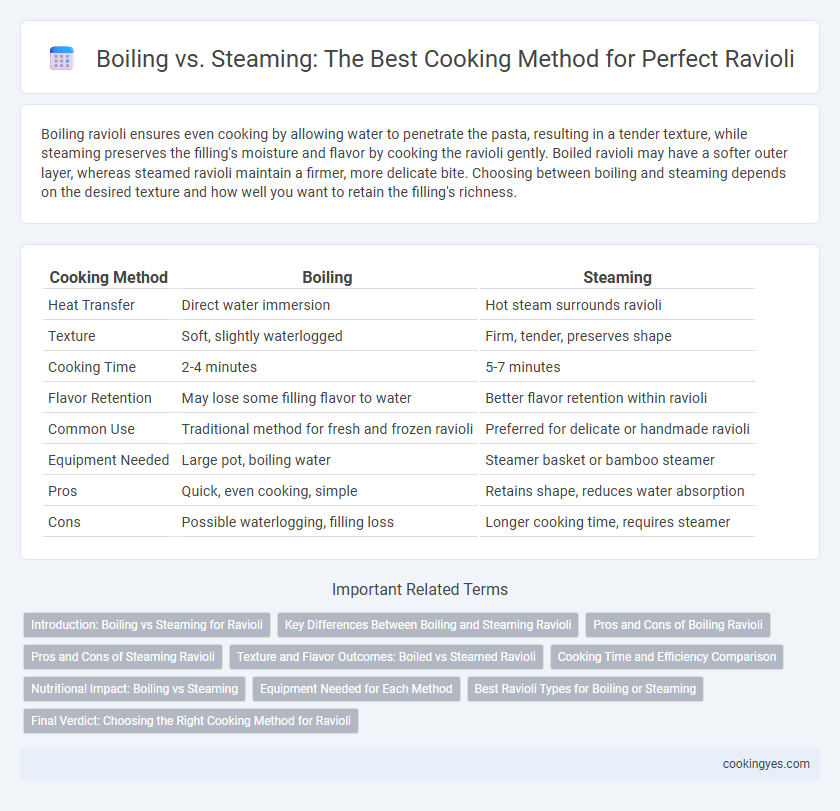Boiling ravioli ensures even cooking by allowing water to penetrate the pasta, resulting in a tender texture, while steaming preserves the filling's moisture and flavor by cooking the ravioli gently. Boiled ravioli may have a softer outer layer, whereas steamed ravioli maintain a firmer, more delicate bite. Choosing between boiling and steaming depends on the desired texture and how well you want to retain the filling's richness.
Table of Comparison
| Cooking Method | Boiling | Steaming |
|---|---|---|
| Heat Transfer | Direct water immersion | Hot steam surrounds ravioli |
| Texture | Soft, slightly waterlogged | Firm, tender, preserves shape |
| Cooking Time | 2-4 minutes | 5-7 minutes |
| Flavor Retention | May lose some filling flavor to water | Better flavor retention within ravioli |
| Common Use | Traditional method for fresh and frozen ravioli | Preferred for delicate or handmade ravioli |
| Equipment Needed | Large pot, boiling water | Steamer basket or bamboo steamer |
| Pros | Quick, even cooking, simple | Retains shape, reduces water absorption |
| Cons | Possible waterlogging, filling loss | Longer cooking time, requires steamer |
Introduction: Boiling vs Steaming for Ravioli
Boiling ravioli is the traditional method that ensures a tender texture and allows even cooking by submerging the pasta fully in hot water, typically at 212degF (100degC). Steaming ravioli preserves the delicate filling and pasta structure by cooking with moist heat around 212degF, reducing the risk of waterlogged or broken pieces. Both techniques impact texture and flavor, but boiling is preferred for a softer bite while steaming maintains a firmer, more intact shape.
Key Differences Between Boiling and Steaming Ravioli
Boiling ravioli involves submerging the pasta in rapidly boiling water, resulting in a quicker cook time and a softer texture due to direct water contact. Steaming ravioli uses steam heat to cook, preserving a firmer texture and reducing the risk of the delicate pasta tearing or the filling leaking. The key difference lies in moisture exposure--boiling introduces more water directly to the pasta, while steaming cooks more gently, maintaining structure and flavor integrity.
Pros and Cons of Boiling Ravioli
Boiling ravioli ensures even cooking and a tender texture by immersing the pasta in hot water, which efficiently heats the filling. However, prolonged boiling can cause delicate ravioli to become waterlogged or break apart, leading to a loss of shape and flavor. This method also requires close attention to cooking times to prevent overcooking and preserve the precise consistency of the pasta dough.
Pros and Cons of Steaming Ravioli
Steaming ravioli preserves delicate textures by gently cooking the pasta without direct contact with water, reducing the risk of sogginess and allowing the filling to remain moist and flavorful. This method offers a healthier alternative by avoiding water absorption and nutrient loss, but can result in less evenly cooked edges compared to boiling. Steamed ravioli may require longer cooking times and careful monitoring to prevent drying out or sticking, making it less convenient for quick preparation.
Texture and Flavor Outcomes: Boiled vs Steamed Ravioli
Boiling ravioli results in a tender texture with a slightly enriched flavor as the pasta absorbs some of the seasoned boiling water, intensifying the filling's taste. Steaming preserves a firmer, more delicate texture, allowing the natural flavors of the filling and pasta to remain distinct and less diluted. Choosing steaming or boiling directly impacts the ravioli's mouthfeel and flavor concentration, making each method suitable for different culinary preferences.
Cooking Time and Efficiency Comparison
Boiling ravioli typically requires 4 to 5 minutes, ensuring even cooking but often uses more water and energy. Steaming ravioli takes slightly longer, around 6 to 8 minutes, preserving delicate textures and flavors while consuming less water and reducing nutrient loss. Comparing efficiency, steaming offers energy savings and better retention of nutrients, while boiling provides faster cooking with more uniform heat distribution.
Nutritional Impact: Boiling vs Steaming
Steaming ravioli retains more nutrients such as B vitamins and minerals by preventing water-soluble nutrient loss that occurs during boiling. Boiling can cause some leaching of proteins and vitamins into the water, diminishing the overall nutritional value of the dish. Steamed ravioli maintains better nutrient density and texture, making it a healthier cooking method.
Equipment Needed for Each Method
Boiling ravioli requires a large pot filled with water and a slotted spoon or spider strainer for easy retrieval without damaging the delicate pasta. Steaming ravioli calls for a steamer basket or a bamboo steamer placed over simmering water, ensuring gentle cooking that preserves the filling's texture. Both methods require stove access and a timer for precise cooking duration.
Best Ravioli Types for Boiling or Steaming
Ravioli stuffed with delicate fillings such as ricotta and spinach are best suited for boiling, as this method gently cooks without drying out the pasta. Heavier or sturdier ravioli varieties, including those filled with meat or mushrooms, benefit from steaming to maintain the integrity of the dough and prevent overcooking. Choosing the appropriate cooking technique enhances texture and preserves the rich flavors of the filling, ensuring the optimal ravioli experience.
Final Verdict: Choosing the Right Cooking Method for Ravioli
Boiling ravioli results in a tender texture with even cooking, ideal for fresh or frozen varieties, while steaming preserves delicate fillings and prevents water absorption, enhancing flavor intensity. Choosing the right method depends on ravioli type and desired texture; boil for a traditional, soft bite or steam to maintain firmness and distinct filling taste. For delicate or homemade ravioli, steaming can prevent overcooking, whereas boiling offers a quicker and more consistent outcome for robust pasta.
Boiling vs Steaming for ravioli cooking method Infographic

 cookingyes.com
cookingyes.com